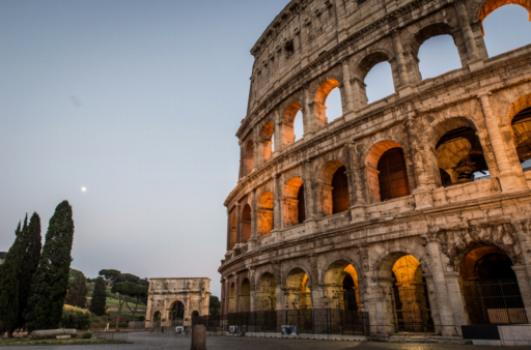Italy is a land rich in history, culture, and spirituality. One of the most renowned sites in Rome, the Holy Stairs, holds a special place in the hearts of pilgrims and visitors alike. This sacred staircase is believed to be the very steps that Jesus climbed during his trial before Pontius Pilate. Join us on a journey as we explore the sanctuaries surrounding the Holy Stairs, discover the significance of this ancient pilgrimage site, and learn about the recent restoration efforts to preserve its historical and spiritual importance. Come discover the tradition of climbing the Holy Stairs in Rome and experience a truly awe-inspiring spiritual ascent towards heaven.

The Sanctuaries along the Holy Stairs: A Spiritual Journey
These ancient stairs are believed to be the same ones that Jesus climbed during his trial before Pontius Pilate. Along the way to the top, pilgrims encounter several sanctuaries that add to the sacredness of the experience.
The Sanctuaries are carefully positioned along the path of the Holy Stairs, offering moments of prayer and reflection for pilgrims. Each sanctuary is adorned with religious artwork and symbols, inviting pilgrims to pause and connect with their faith. The presence of these sanctuaries creates a sense of reverence and awe, enhancing the spiritual journey towards the top of the stairs.
As pilgrims ascend the Holy Stairs and visit the sanctuaries along the way, they are encouraged to reflect on their own spiritual journey and seek inner peace and forgiveness. The experience of climbing these ancient steps is a powerful reminder of the trials and tribulations of life, and the importance of faith in overcoming them.
The Sanctuaries along the Holy Stairs serve as a beacon of hope and inspiration for pilgrims, guiding them on a spiritual journey towards a deeper connection with their faith. The presence of these sanctuaries adds depth and meaning to the experience of climbing the Holy Stairs, making it not just a physical ascent, but a transformative journey of the soul.
Pilgrimage to the Scala Sancta: Steps to Heaven
Believed to be the stairs that Jesus climbed during his trial before Pontius Pilate, the Scala Sancta holds great significance for Christians seeking a spiritual experience. Climbing the 28 marble steps on their knees, pilgrims recite prayers and meditate on the passion of Christ as they make their way up the stairs.
For centuries, the Scala Sancta has drawn devout believers from around the world, who come to seek forgiveness, healing, and spiritual renewal. The act of climbing the stairs on one's knees is seen as a form of penance and devotion, a physical and emotional offering to God. Many pilgrims report feeling a profound sense of peace and connection with the divine as they ascend the stairs, their faith strengthened and their souls uplifted.
The pilgrimage to the Scala Sancta is not just a physical journey, but a spiritual one as well. It is a reminder of Christ's sacrifice and a call to reflect on one's own relationship with God. The steps to heaven are not just a physical ascent, but a metaphorical one as well, symbolizing the path to salvation and eternal life.
As pilgrims make their way up the Scala Sancta, they are united in a common purpose – to seek forgiveness, grace, and spiritual transformation. The journey may be challenging, both physically and emotionally, but it is a powerful and meaningful experience that can deepen one's faith and bring them closer to God. Whether seeking solace, healing, or simply a closer connection with the divine, the pilgrimage to the Scala Sancta offers a sacred and profound opportunity for spiritual growth and renewal.
The Restoration of the Holy Stairs: Preserving a Sacred Site
The restoration of the Holy Stairs is a crucial effort to preserve one of the most sacred sites in Rome. The steps, believed to be those that Jesus climbed during his trial before Pontius Pilate, hold immense religious significance for Christians around the world. Over the years, the steps have deteriorated due to the heavy foot traffic of pilgrims and tourists. In order to ensure that future generations can continue to experience the spiritual power of the Holy Stairs, preservation efforts have been undertaken to repair and protect this historic site. Through careful restoration work, the sanctity of the Holy Stairs is being maintained, allowing visitors to continue their spiritual journey along these hallowed steps.
The Devotion and Tradition of Climbing the Holy Stairs in Rome
According to tradition, these stairs are the same ones that Jesus climbed during his Passion, making them a symbol of spiritual significance for Christians.
Climbing the Holy Stairs is a ritual that dates back centuries, with believers ascending the 28 steps on their knees as a way to connect with the suffering of Christ. This act of piety is seen as a way to seek forgiveness for sins and to strengthen one's faith.
The devotion to the Holy Stairs is evident in the large number of pilgrims who make the journey to Rome each year to experience this sacred tradition. The stairs are located in the Pontifical Sanctuary of the Holy Stairs, where visitors can also find relics and mementos associated with Jesus' crucifixion.
Overall, the climbing of the Holy Stairs is not just a physical act, but a spiritual one that allows believers to reflect on the sacrifice of Christ and draw closer to God. The tradition of climbing these stairs serves as a reminder of the importance of faith, humility, and repentance in the Christian tradition.
